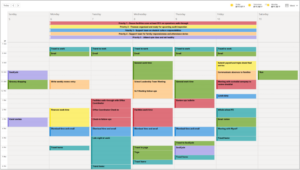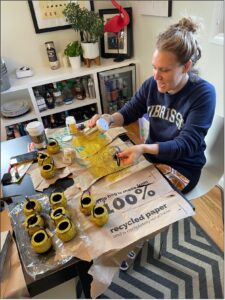I’m continuing my obsession with teachers who help students keep their time, space, and stuff Together. Last year, I wrote about student planners, binders and visual anchors. I’m going to start off a three-part series on Together Students. It feels timely since many of you are considering how to best serve your students next year. So featured today is Jessie R., a high school biology teacher who I met in New Orleans last summer. I was instantly attracted to how she supported her students in purposefully organizing their instructional learning materials.
1. Student Notebooks
The Scene
Kids come in and pick up a Do-Now & Exit Ticket Packet, along with their colored notebook from the entrance station.
The Set-Up
- Notebooks are organized by color and number to decrease the amount of time spent fumbling upon entrance
- Each color is in a different crate in a different part of the room to prevent a bottleneck
The colors don’t represent anything in particular (Except notebooks on sale!!! Hey, teachers get it where they can, right?!), though Jesse is considering the colors representing lab groups next year.


The System
- Notebooks stay in class except for the night before a test
- Notebooks must be returned on test day, when Jessie grades them on organization
- Notebooks are graded on a very simple rubric, sometimes by other students
Jessie was also kind enough to share her rubric below.

Jessie’s Student Notebook Rubric
2. Flashcards
The Scene
Jessie describes, “Flashcards are used for essential vocabulary. The flashcards often include pictures or steps of processes that students will need to complete homework. Students bring flashcards home each night and back to school in the morning. If they will not need them, they may choose to leave them in the classroom.”

The Set-Up
- Flashcards are held on binder rings and stored in Ziploc bags
- Each flashcard set has one colored card on top, where kids write their names
- This helps save lost flashcard sets and saves Jessie the time of flipping through all cards to find a name scribbled on one
- Flashcards have one hole punched in them
- Jessie has a flashcard station with box of single hole punchers and a box of flashcards that kids access as needed during independent practice
- Flashcards and vocabulary words have matching numbers
- Jessie keeps a Google Doc with the list of numbered vocab, and also includes the number on each new word’s PowerPoint slide
- She also keeps a running numbered list on the Word Wall in her classroom
- If a scholar is absent, he can look through a friend’s ring and copy the numbered cards he’s missing
The System
- Students clip the Ziploc bag into their binder (binders are used school-wide)
- If they won’t need their flashcards at home, scholars also have the option to leave their flashcards clipped to their school notebooks
- Flashcards are graded as random pop “preparedness” quizzes
- Approximately every two weeks during the Do Now, Jessie will ask the class to place their flashcards on their desks as they enter
- While she circulates, she checks off their names on a class roster
- If all students have all of their flashcards (almost all usually do), they get an automatic 100%; if they don’t, they get a zero on a quiz grade that they can’t make up
I love the time and effort Jessie put into creating the notebook and flashcard systems – and then having her students really own the set-up and system maintenance. Many teachers just focus on materials functioning efficiently, but Jessie is also using these systems to help reinforce her instruction. While I’m sure it’s controversial in some places, I like that she holds her students accountable by grading them on their level of preparedness.
Reader Question: How do you teach your students to keep their materials Together?


